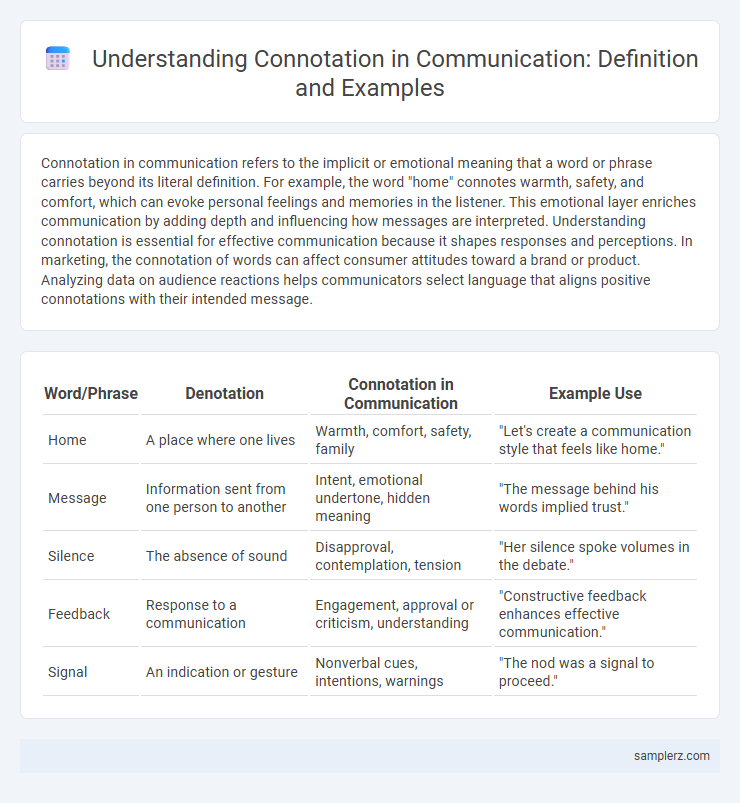Connotation in communication refers to the implicit or emotional meaning that a word or phrase carries beyond its literal definition. For example, the word "home" connotes warmth, safety, and comfort, which can evoke personal feelings and memories in the listener. This emotional layer enriches communication by adding depth and influencing how messages are interpreted. Understanding connotation is essential for effective communication because it shapes responses and perceptions. In marketing, the connotation of words can affect consumer attitudes toward a brand or product. Analyzing data on audience reactions helps communicators select language that aligns positive connotations with their intended message.
Table of Comparison
| Word/Phrase | Denotation | Connotation in Communication | Example Use |
|---|---|---|---|
| Home | A place where one lives | Warmth, comfort, safety, family | "Let's create a communication style that feels like home." |
| Message | Information sent from one person to another | Intent, emotional undertone, hidden meaning | "The message behind his words implied trust." |
| Silence | The absence of sound | Disapproval, contemplation, tension | "Her silence spoke volumes in the debate." |
| Feedback | Response to a communication | Engagement, approval or criticism, understanding | "Constructive feedback enhances effective communication." |
| Signal | An indication or gesture | Nonverbal cues, intentions, warnings | "The nod was a signal to proceed." |
Understanding Connotation in Communication
Understanding connotation in communication involves recognizing the subtle emotional and cultural associations a word or phrase carries beyond its literal meaning. For example, describing someone as "childlike" conveys innocence and wonder, while "childish" implies immaturity, affecting how the message is perceived. Effective communicators use connotative meanings to evoke desired responses and create deeper connections with their audience.
The Role of Connotation in Effective Messaging
Connotation in communication shapes how messages are perceived by associating words with emotions and cultural meanings beyond their literal definitions. For example, describing a project as "ambitious" conveys a positive sense of determination, while calling it "risky" highlights potential drawbacks, influencing audience reaction. Leveraging connotative language effectively enhances message impact, fostering clearer understanding and emotional connection.
Positive Connotations: Encouraging Friendly Dialogue
Positive connotations in communication foster an atmosphere of trust and openness, encouraging friendly dialogue. Words like "supportive," "collaborative," and "empathetic" convey respect and understanding, creating a welcoming environment that motivates participants to share ideas freely. This enhances relationship building and promotes effective teamwork.
Negative Connotations: Avoiding Misinterpretation
Negative connotations in communication, such as describing a colleague as "stubborn" instead of "persistent," can lead to misunderstandings and damaged relationships. Words with negative undertones may evoke unintended emotions, causing the receiver to feel criticized or undervalued. Carefully choosing neutral or positive language helps prevent misinterpretation and fosters clearer, more effective exchanges.
Cultural Influences on Connotative Meaning
Cultural influences significantly shape the connotative meaning of words, as phrases or symbols may evoke different emotions or associations across societies. For example, the color white is commonly associated with purity in Western cultures, while in some Eastern cultures it connotes mourning and death. Understanding these cultural nuances is essential for effective communication to avoid misunderstandings and convey intended messages accurately.
Connotation vs. Denotation: Key Differences
Connotation in communication refers to the emotional or cultural meaning attached to a word beyond its literal definition, while denotation is the precise, dictionary meaning. For example, the word "home" denotes a place where one lives, but its connotation includes feelings of warmth, safety, and comfort. Understanding the distinction between connotation and denotation is essential for effective messaging, as it influences how the audience interprets and responds to language.
Connotative Language in Business Communication
Connotative language in business communication enhances message impact by evoking emotions and cultural associations beyond literal meanings, such as using "investment" instead of "expense" to imply growth potential. Effective use of connotative terms builds rapport and trust, influencing stakeholder perception and decision-making. Misunderstanding or misusing connotations, however, can lead to confusion or negative reactions, highlighting the importance of audience awareness in corporate messaging.
Real-Life Examples of Connotation in Everyday Speech
In everyday speech, the word "home" often carries a warm connotation of comfort and security beyond its literal meaning as a physical dwelling. For instance, telling someone "welcome home" conveys emotional belonging and safety rather than just a location address. Similarly, describing a person as "childlike" implies innocence and purity, which contrasts with the more neutral or negative denotation of immaturity.
The Impact of Tone and Word Choice on Perception
Tone and word choice significantly influence how messages are perceived, often carrying connotations that extend beyond literal meanings. For instance, describing a project as "ambitious" can suggest enthusiasm and innovation, while labeling it "risky" may provoke caution and doubt. These nuanced connotations shape the audience's emotional response and interpretation, highlighting the critical role of careful linguistic selection in effective communication.
Enhancing Clarity by Managing Connotations
Managing connotations in communication enhances clarity by choosing words with neutral or positive associations to avoid misunderstandings. For example, instead of describing feedback as "criticism," using terms like "suggestions" or "recommendations" fosters constructive dialogue. This strategic word choice aligns the intended message with the receiver's perception, minimizing ambiguity and promoting effective understanding.

example of connotation in communication Infographic
 samplerz.com
samplerz.com